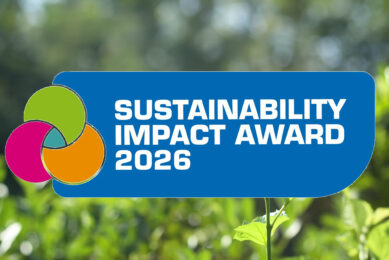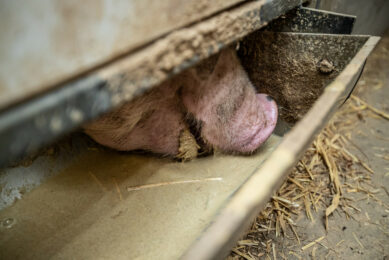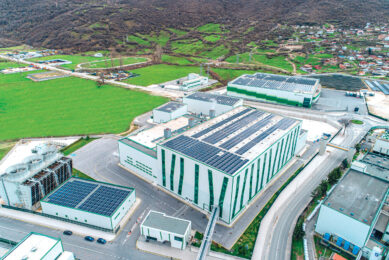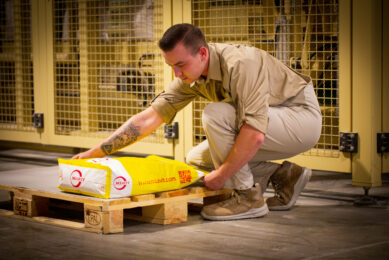Enriching the environment for broilers using a laser device

What we see today in modern broiler production is a fast growing broiler that is usually susceptible to leg disorders and inactivity towards market weight. Devices or strategies that improve environmental enrichment might motivate broilers for better movement and feeding, all contributing to improved welfare.
The selection for increased growth rate contributes to about 30% of modern commercial broilers suffering from leg lameness. Lameness contributes to decreased time standing or walking. This inactivity increases bird-litter contact, resulting in breast blisters and foot lesions due to contact dermatitis. Dermatitis is painful and could compromise broiler performance and welfare. In a bid to improve broiler activity and performance, researchers at Iowa State University have recently published interesting results of their research on the use of a laser device to enrich broiler environment; their findings are discussed here.
The laser device and set-up
The laser device aimed at stimulating broilers visually and motivate physical movement through increased walking distance and improved walking ability. This was done by slowly moving small particle-sized red laser dots projected onto broiler pen floors throughout the rearing period as special environment enrichment.
A total of 10 novel laser enrichment devices designed and built specifically for this research were affixed over 20 pens, and the other 20 pens as control. Each device was designed and calibrated to cover 2 adjoining pens. 7 laser and 7 control pens, with 5 focal birds/pen, were randomly selected to be video-recorded from day 0 to 8 and once weekly for the 6-week trial period. These focal birds had wing bands and were colour-marked (red, blue, green, purple, and black). The enrichment device consisted of 2 independent red 650 nm lasers contained within a 20.5 by 20.5 cm metal box with a glass bottom mounted on a custom-designed structure made of 3 wooden beams (2.4 m height) raised above the pens. The lasers projected in a random pattern at a range of 7.6 to 30.5 cm/s onto the pen floor for 4-min “laser periods”: 05:30 to 05:34, 11:30 to 11:34, 17:30 to 17:34, and 23:30 to 23:34 daily for the entire trial period.
Results of laser enrichment
1. Response towards feed
The response of birds towards and at the feeder was recorded in both laser and control pens as direct comparative measure. Latency to feed measures were categorised into 4 mutually exclusive categories:
- at feeder during laser period only,
- at feeder when laser turned off,
- went to feeder <5 minutes following laser turn off, and>
- never went to feeder (Figure 1).
‘At feeder’ meant bird head over feeder circle, bird in feeder or bird standing on feeder tray. Over week 1 to 6, about 61% of focal birds in the laser treatment were at the feeder during or within 5 min following laser periods. Laser birds spent more time at the feeder on days 0, 1, 2, 5, 8, and on weeks 1 and 5, with 84% more time at feeder than control birds on day 5. The researchers suggested the presence of birds at the feeder during laser periods and the increased time spent at feeder in laser birds not only did it indicate an increase in bird movement but may have also encouraged feeding, perhaps by stimulating natural foraging or predatory behaviour.
Figure 1 – Weekly breakdown of Ross 308 broiler latency to feed of laser focal birds (week 1 -6).

2. Walking distance
The distance walked by the blue-coloured focal bird in each video-recorded pen was measured over the 4-min laser periods (days 0 to 9, and week 2 to 5). The observing researcher used a custom ruler tool to measure the interconnecting lines drawn from video. This was repeated for each individual minute and then a sum of all line measurements, or the total distance walked each period, was calculated. Laser birds walked further during laser periods on day 0 to 8 and week 2 to 5. Laser birds covered the longest distance on day 1 and during week 2. Compared to the control, laser birds walked 646.5 cm further (day 1) and 367.5 cm (week 2). Overall, the time spent active was increased in laser treatment by 114% on week 2; 157% on week 3; 90% on week 4; and 82% on week 5. ‘Active’ meant bird legs were in a continuous forward motion (walking or running), and ‘inactive’ meant bird stood in one place or rested its abdomen on the litter, head rested or raised while any part of its body was or was not in contact with another bird.
3. Walking lameness
All birds were removed from their pens once a week and assessed for lameness. In the laser group there were no birds showing lameness, while the control birds had about 1% with lameness.
Birds either walked 1.5 m independently or were encouraged to walk:
- a researcher slowly moving their hand back and forth directly behind the bird
- a researcher gently tapping the bird on the vent region with a gloved hand or
- a researcher both waving behind and gently tapping the bird with a ping pong paddle.
Individual birds were considered to have completed the task when both feet had crossed into the finish section. Scores were assigned using a 0 to 2 scale where 0 indicated the ability to walk 1.5 m with no signs of lameness, 1 indicated the ability to walk 1.5 m but showed unevenness in steps or sat down at least once, and 2 indicated a bird that could not walk 1.5 m (lameness).
4. Maximal body weight effect
The researchers found it interesting that during week 6 there were no differences in proportion of active/inactive behaviour due to enrichment. They suggested a result of maximal body weight overriding motivation to move as birds neared the end of the grow-out period, rather than habituation to the lasers – as a similar pattern is seen in previous studies that observed a decline in the use of perches after week 5 in broilers.
What we know now
- The laser enrichment device is effective in stimulating (not forcing) broiler physical activity (walking or running) and positively impacting behaviour towards feeding – possibly improving performance. This highlights that moving light/visual enrichment successfully motivates broiler activity resulting in reduced incidence of lameness and better bird welfare.
- The laser device is practical and applicable to commercial barns without changing grow-out procedures or negatively impacting bird welfare or performance but rather improving. The inclusion of this device would not require altered management or human labour to increase bird activity and could be easily cleaned and reused over multiple flocks. In addition, birds cannot physically interact with the device (no changes to biosecurity/cleaning are needed between flocks), this avoids object-guarding behaviour within the bird hierarchy.
- The effectiveness of this laser device plateaus towards the finishing period of broilers. Researchers attributed this to maximal body weight overriding motivation to move as birds neared the end of the grow-out period, rather than habituation to the lasers.






